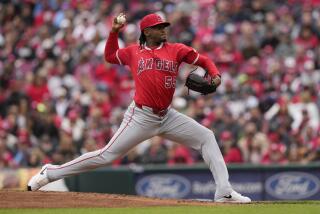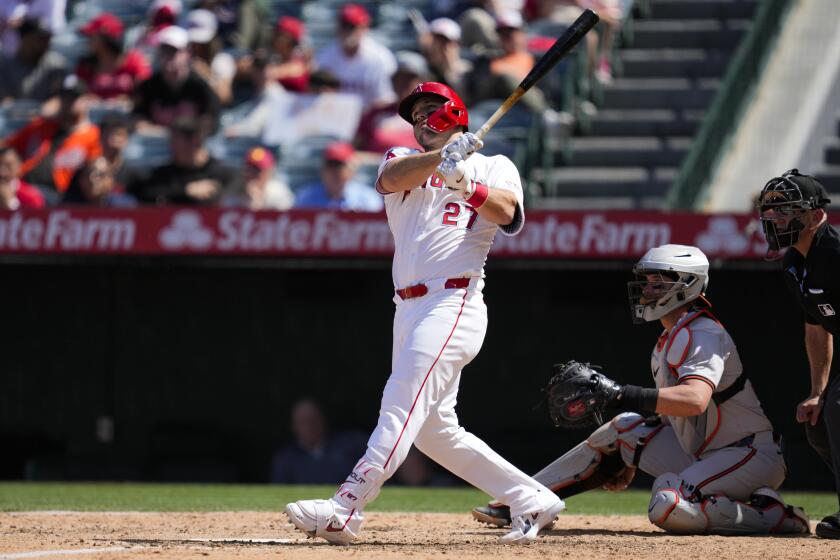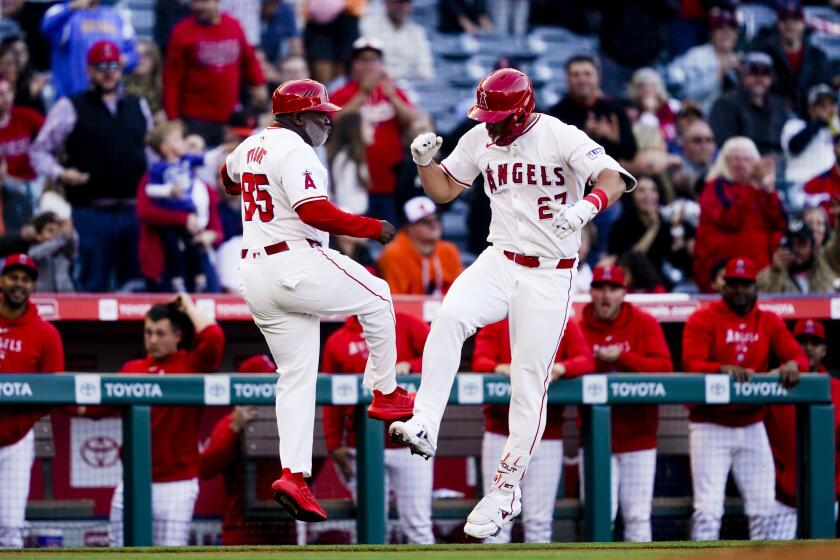Rich Prospectus
As outrageous as it sounds, Oakland General Manager Billy Beane was actually hoping the Angels would trade for Manny Ramirez or Miguel Tejada this winter, even though such a deal would probably have assured the Angels of a third straight division title.
“I wouldn’t have been thrilled to have one of those guys over there,” Beane said, “but if they had given up some of the guys who were being talked about in deals, I would have been OK with that.”
Beane also wouldn’t have minded if slugger Paul Konerko or another free agent or two had signed with the Angels.
“Put it this way,” Beane said, “I was disappointed they didn’t go out and sign a bunch of older guys who would stand in the way of those [prospects] because those guys are legitimate. They have one of the best farm systems in the game. They’re not just good players; they’re going to be great players.”
Most teams go out of their way to tout their top prospects, some to the point of overvaluing them, but there seems to be a consensus about the Angels’ current batch of youngsters, a list headed by shortstops Brandon Wood and Erick Aybar, second baseman Howie Kendrick, pitcher Jered Weaver and first baseman Kendry Morales.
When Baseball Prospectus ranks five of your organization’s players among the top 50 prospects in the game; when Baseball America rates seven of your players among baseball’s top 100 prospects; when scouts and executives from other teams rave about your kids; when other general managers keep asking for the same players in trades, and your GM refuses to part with them, even for a player of Ramirez’s caliber
“We’re not hyping anyone -- we’re just responding to questions about why we’re not bringing in a big bat,” Angel General Manager Bill Stoneman said, alluding to his oft-repeated winter mantra that he’s not going to gut the farm system for one player. “That feeds the hype, if that’s what you want to call it, but for me, it’s not hype. We put a focus on a key element of our business, and it looks like it’s going to pay off.”
Though owner Arte Moreno has the money to acquire high-salaried veterans through free agency and trades, Stoneman has remained loyal to his player-development roots, which were shaped by his formative years in Montreal and honed in his early years as Angel GM under the tight-fisted Walt Disney Co.
Stoneman saw the New York Yankees and Atlanta Braves underachieve in the 1980s because “they relied on free agents and trades for high-salaried players and traded away the better players in their farm system,” Stoneman said. “You look at that and say, ‘What’s going on here?’ These were two of the highest-revenue teams in baseball, and it didn’t make sense that they weren’t in the playoffs all the time.”
That changed when the Braves hired Bobby Cox as GM in 1985 and the Yankees realized they had a farm system. Instead of pursuing overpriced veterans, the Braves started purging them -- in one key deal, Cox sent aging right-hander Doyle Alexander to Detroit in 1987 for a Class-A pitcher named John Smoltz.
The Braves drafted and developed such players as Tom Glavine, Steve Avery, Chipper Jones and David Justice, who helped provide the foundation for 14 consecutive division titles and a World Series championship in 1995.
The Yankees didn’t discard their free-spending, free-agent ways. But they began holding on to such talented home-grown players as Bernie Williams, Derek Jeter, Jorge Posada and Mariano Rivera, and they formed the core of the team that won four World Series titles from 1996 to 2000.
“Both teams did it the same way -- they recognized the importance of the draft and stopped trading away good young talent,” Stoneman said. “And they stopped signing free agents who were not impact guys.”
Stoneman, convinced that model would work in Anaheim, instituted a draft philosophy that was a 180-degree turn from his predecessors -- the Angels, under scouting directors Donny Rowland and later Eddie Bane, would target higher-risk, higher-ceiling kids, often choosing high school players heavy in raw talent over more refined college players who might have been closer to the big leagues but had less potential.
A perfect example: In 2004, the Angels used a 14th-round pick on Nick Adenhart, a 17-year-old right-hander who was projected as a first-round pick before undergoing reconstructive elbow surgery in his senior year of high school.
The Angels gave Adenhart second-round money ($710,000), steered his rehabilitation, and this spring he spent four weeks in major league camp, showing promise with his wiry, 6-foot-3, 185-pound frame and explosive fastball.
“We try to take intelligent risks,” Stoneman said. “I have a strong belief that you should go after a guy who might be an All-Star, not just a major leaguer. If you go after the safer pick, you have a chance to be an average club.”
Stoneman’s domestic approach, along with the Angels’ reinvestment in a Latin American program that virtually disappeared in the late 1990s, has resulted in a farm system that may be a little thin on pitching depth and power-hitting outfielders, but can now boast of:
* Wood, a shortstop who hit .321 with 43 home runs and 115 runs batted in at Class-A Rancho Cucamonga last season, hit an Arizona Fall League-record 14 home runs and a league-leading 32 RBIs, is rated baseball’s third-best prospect by Baseball America and has drawn comparisons to Cal Ripken Jr.
* Kendrick, a muscular second baseman who showed his eye-popping averages at Class A (.368 in 2003, .367 in 2004, .384 in 2005) were not a fluke by batting .342 in half a season at double-A Arkansas in 2005, and who is ranked 12th on Baseball America’s list.
* Aybar, a speedy, slick-fielding shortstop whom the Angels believe is ready for the big leagues defensively but needs at least a year of offensive seasoning at triple-A Salt Lake. Baseball America ranks Aybar 46th on its top 100 list.
* Weaver, first-round pick in 2004, a $4-million bonus baby whose live arm, excellent command and uncanny feel for pitching could catapult him into the big leagues later this season. Weaver, the younger brother of Angel pitcher Jeff Weaver, is rated 57th on Baseball America’s list.
* Morales, the Cuban first baseman who has shown power from both sides of the plate this spring and who could be an offensive force once he learns how to hit a major league breaking ball and develops some more plate discipline. Baseball America rates Morales 78th.
The Angels also have four young players who are expected to make an impact on this year’s major league club, pitcher Ervin Santana (23), first baseman Casey Kotchman (23), catcher Jeff Mathis (23) and third baseman Dallas McPherson (25).
The abundance of near-ready prospects could present some logistical problems -- some players probably will have to switch positions to accommodate the needs of the big league club, though the Angels believe in developing a prospect to his full potential at his natural position before making such a move.
But the benefits are huge: By constantly replenishing the big league club with good, young and inexpensive players and letting such higher-priced veterans as Troy Glaus, Troy Percival and Bengie Molina go, the Angels can keep their payroll down and free up money to target other high-priced players, especially starting pitchers.
“Fans don’t focus on that, but it’s really important,” Stoneman said. “We have a sizable player budget, but it isn’t limitless. We know how the salary system works, and when you have very talented players breaking through to the major leagues, the benefit is you’re able to use your money to plug other positions.”
So, for Angel fans wondering why Stoneman wouldn’t part with Kendrick and Wood in a Ramirez deal, it’s because Kendrick is expected to replace second baseman Adam Kennedy in 2007, and Wood could be ready by 2008.
In two years, the Angels could have an infield of Kotchman at first, Kendrick at second, Wood or Aybar at short, McPherson at third, Mathis behind the plate and Morales at DH. None would cost more than $1 million.
That would free up resources to sign Vladimir Guerrero and perhaps Bartolo Colon and Kelvim Escobar to extensions. There would be plenty of money to pursue another free-agent slugger or a top pitcher such as Oakland left-hander Barry Zito, who will be a free agent next winter.
And wouldn’t that be the ultimate knife-twister for Beane, to lose his ace to a division rival, in part because the Angels did such a good job of developing young players they had the wherewithal to sign Zito?
“I’ve seen enough of those guys to wish they’d go away,” Beane said of the Angel prospects. “Unfortunately, I’ll see more of them over the next 10 years than I care to see. They’re not going to be just good. They’re going to be real good.”
More to Read
Go beyond the scoreboard
Get the latest on L.A.'s teams in the daily Sports Report newsletter.
You may occasionally receive promotional content from the Los Angeles Times.






